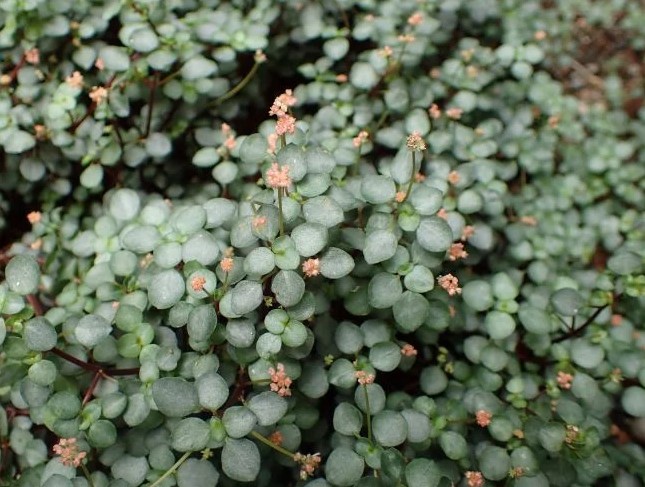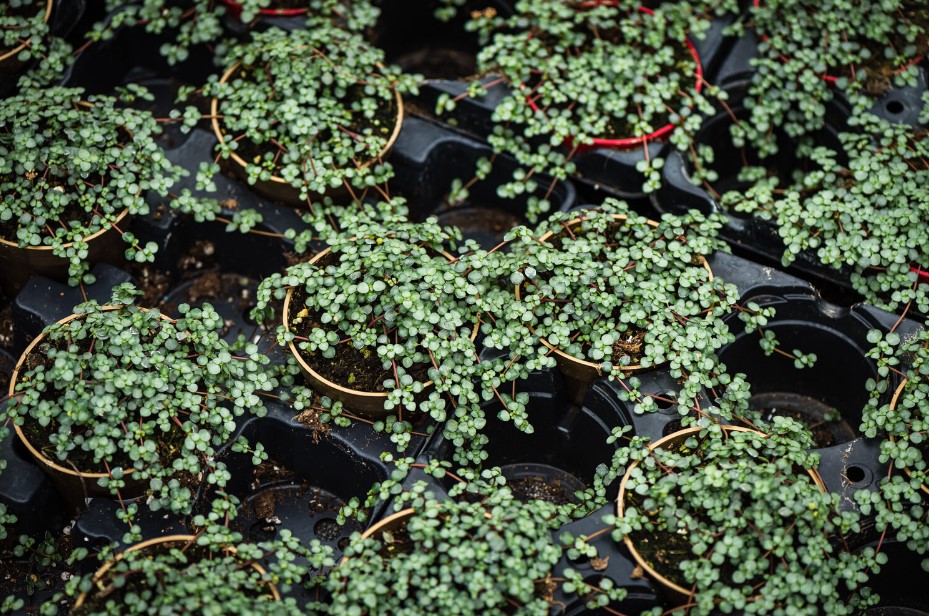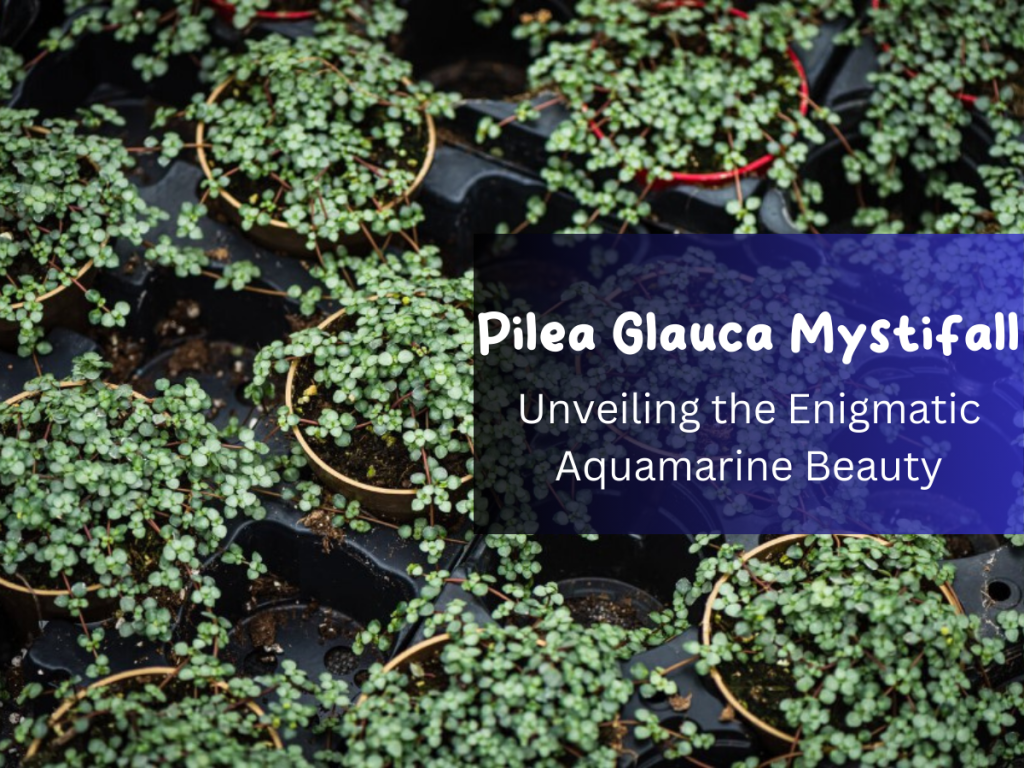Pilea glauca ‘Mystifall,’ also known as the Aquamarine Pilea, is a mesmerizing plant that has gained significant popularity among houseplant enthusiasts. With its delicate leaves and unique growth habit, this captivating species has become a sought-after addition to indoor gardens. In this article, we will explore Pilea glauca ‘Mystifall’s fascinating characteristics, including its origin, care requirements, propagation methods, and the benefits of incorporating this stunning plant into your home.
Origin and Appearance:
Pilea glauca ‘Mystifall’ is a member of the Urticaceae family and is native to the rainforests of Central and South America. Its distinctive feature lies in its cascading growth habit, whose small, round leaves hang gracefully on trailing stems. The leaves, which are light green with a hint of silvery blue, have a velvety texture that adds to their visual appeal. The overall effect of this plant is a delicate, waterfall-like display that enchants any space it occupies.

Care Requirements:
Light: Pilea glauca ‘Mystifall’ thrives in bright, indirect light. It prefers a well-lit spot near a window, but direct sunlight should be avoided as it can scorch the leaves.
Temperature: This plant prefers average to warm temperatures ranging between 65°F and 75°F (18°C to 24°C). Keeping it away from cold drafts or sudden temperature fluctuations is vital.
Humidity: Pilea glauca ‘Mystifall’ appreciates moderate to high humidity levels. Misting the leaves or placing a humidifier nearby can help recreate its natural rainforest habitat.
Watering: The watering requirements for Pilea glauca ‘Mystifall’ are moderate. It is crucial to keep the soil consistently moist but not soggy. Watering frequency will depend on the season, temperature, and humidity levels.
Soil and Fertilizer: Well-draining soil with a mixture of peat moss, perlite, and organic matter is ideal for this plant. Use a balanced liquid fertilizer diluted to half-strength during the growing season (spring and summer) to promote healthy growth.
Propagation:
Pilea glauca ‘Mystifall’ can be propagated through stem cuttings. Here’s a step-by-step guide to successfully propagate your plant:
Step 1: Select a healthy stem with a few sets of leaves.
Step 2: Using clean, sharp shears, make a clean cut just below a node (the point where the leaf meets the stem).
Step 3: Remove the lower leaves, and bare a small branch section.
Step 4: Place the cutting in a small container with a moistened mixture of soil and perlite.
Step 5: Keep the container in a warm, well-lit area, avoiding direct sunlight.
Step 6: Mist the cutting regularly to maintain humidity and prevent the soil from drying out.
Step 7: After a few weeks, the cutting should develop roots. At this stage, you can transfer it to a larger pot.
Benefits of Pilea glauca ‘Mystifall’:
Air Purification: Like many houseplants, Pilea glauca ‘Mystifall’ improves indoor air quality by removing toxins and releasing oxygen.
Aesthetic Appeal: The unique cascading growth habit and vibrant foliage of Pilea glauca ‘Mystifall’ make it a stunning addition to any interior space. It can be displayed in hanging baskets, on shelves, or as part of a plant arrangement.
Stress Relief: Gardening and caring for indoor plants, such as Pilea glauca ‘Mystifall,’ has reduced stress levels and improved overall well-being.

Conclusion:
Pilea glauca ‘Mystifall’ is a beautiful plant that brings a touch of elegance to any indoor garden. Its cascading growth habit, combined with its velvety silver-blue leaves, creates a mesmerizing display. You can enjoy the beauty of this beautiful plant by providing the right conditions, including adequate light, humidity, and moisture. Whether you’re a seasoned plant enthusiast or a beginner, Pilea glauca ‘Mystifall’ will surely delight and add a unique touch to your home or office space. Read article about Cactus Corking: Exploring Causes, Effects, and Remedies and Etiolation Cactus in Avi Hoffman Garden.
FAQ
Yes, Pilea glauca is generally considered an easy plant to care for. It is known for its adaptability and resilience, making it suitable for beginner and experienced plant owners.
To care for Pilea glauca, consider the following guidelines:
Lighting: Place the plant in bright, indirect light. Avoid direct sunlight, as it can scorch the leaves.
Temperature: Maintain average to warm temperatures between 65°F and 75°F (18°C to 24°C). Please protect it from cold drafts.
Humidity: Pilea glauca prefers moderate to high humidity levels. Misting the leaves or using a humidifier can help increase humidity.
Watering: Keep the soil consistently moist but not waterlogged. Water when the top inch of soil feels dry. Adjust the watering frequency based on environmental conditions.
Soil and Fertilizer: Use well-draining soil enriched with organic matter. Fertilize with a balanced liquid fertilizer diluted to half strength during the growing season (spring and summer).
Several factors can cause Pilea glauca to drop leaves:
Overwatering: Excessive moisture can lead to root rot, causing leaves to turn yellow and drop. Ensure proper drainage and allow the soil to dry out slightly between waterings.
Underwatering: Inadequate watering can cause the plant to become dehydrated, resulting in leaf loss. Check the moisture level regularly and water when needed.
Lighting: Insufficient light or sudden changes in lighting conditions can cause leaves to drop. Ensure the plant receives adequate indirect light.
Temperature and humidity: Extreme temperature fluctuations or low humidity levels can stress the plant and lead to leaf drop. Maintain stable conditions and provide sufficient moisture.
If by “silver tears plant” you are referring to Pilea glauca ‘Mystifall’ or a similar variety with silver-blue leaves, the care requirements are identical to regular Pilea glauca. Here’s a summary:
Lighting: Provide bright, indirect light while avoiding direct sunlight.
Temperature: Maintain average to warm temperatures between 65°F and 75°F (18°C to 24°C).
Humidity: Aim for moderate to high humidity levels. Misting or using a humidifier can help.
Watering: Keep the soil consistently moist but not soggy. Allow the top inch of soil to dry before watering again.
Soil and Fertilizer: Use well-draining soil and fertilize with a balanced liquid fertilizer at half strength during the growing season.
By following these care tips, you can ensure the health and beauty of your Pilea glauca or silver tears plant. Remember to monitor its condition regularly and adjust care as needed.







